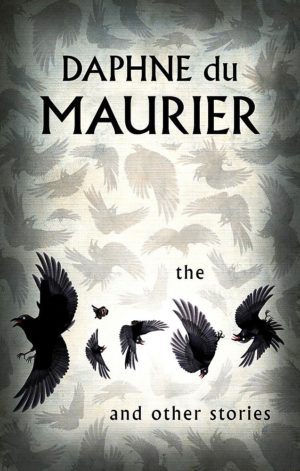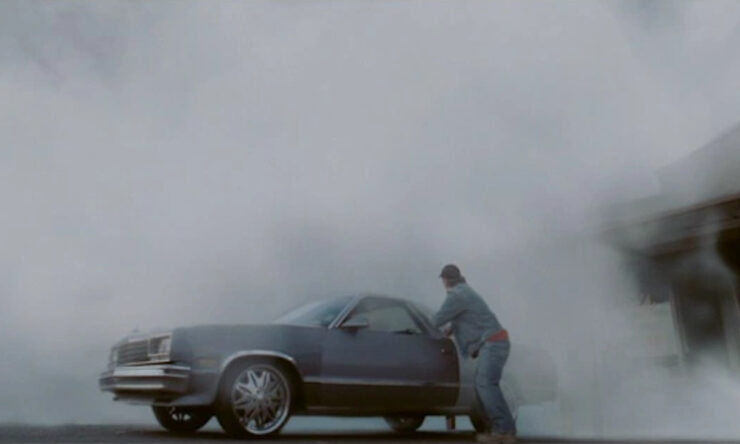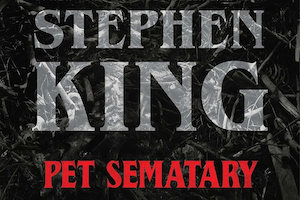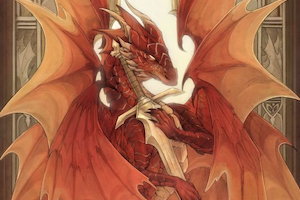Welcome back to Reading the Weird, in which we get girl cooties all over weird fiction, cosmic horror, and Lovecraftiana—from its historical roots through its most recent branches.
This week, we cover Daphne Du Maurier’s “The Birds,” first published in her 1952 collection The Apple Tree (now reprinted as The Birds and Other Stories). Spoilers ahead. CW for (bird) suicide attacks and harm to eyes.
“Black and white, jackdaw and gull, mingled in strange partnership, seeking some sort of liberation, never satisfied, never still.”
Pensioned by disability from WWII, Nat Hocken works part-time at a farm on the Cornwall coast. He’s married with two young children, but has a solitary disposition. Middays he carries his lunch to cliffs overlooking the sea. In spring he watches the birds fly inland, purposeful, intent. In autumn those that don’t migrate are restless and uneasy. “And like people who, apprehensive of death before their time, drive themselves to work or folly, the birds do likewise.”
This autumn, Nat observes that the birds are more agitated than previous years, and far more numerous. Farmer Trigg forecasts a change in the mellow weather, with a hard winter to come, and on December 3 his prediction proves correct. Overnight, a cold dry wind roars in from the east. Disturbed by its booming in the chimney, Nate lies awake watchful. An odd tapping draws him to the window. When he opens it, something jabs his knuckles, then flutters off. Presently the tapping repeats, louder. Nat opens the window and several birds fly at his face. Then children Jill and Johnny start screaming. In their bedroom the darkness whirs with birds. Nat hurries the children out to his wife and returns to flail at the intruders with a blanket. Beaks tear his hands and head. Bodies thud. Dawn light calls the surviving birds away, but fifty small corpses remain: robins, finches, sparrows, larks. Nat suggests that the weather drove them from up-country, but recognizes local species.
By morning black frost hardens the earth. Apprehensive, Nat walks Jill to the schoolbus. Birds are strangely absent. Afterwards he stops at the farm. Cowman Jim and Mrs. Trigg appear incredulous of his story. He collects the dead birds from the children’s room and takes them to the beach for burial. The wind and cold are brutal, but gulls ride the waves: tens of thousands in packed formations. Nat debates reporting the uncanny gathering, but the police would scoff. He’s relieved when his wife reports a special bulletin on the wireless: All over the country birds are obstructing normal activities, even attacking people. Heeding the official warning to reinforce houses, Nat boards up windows and chimneys. Remembering how he made blackout boards for his mother’s house at Plymouth, he wonders if people like the Triggs, who were little affected by German air raids, will take precautions.
Further bulletins describe a London under avian siege. Authorities speculate that an Arctic airstream has driven birds southward. Nat thinks the announcer treats the business too lightly and imagines Londoners throwing drunken bird-watching parties. His wife complains that the government should have the army shoot the birds. Nat confines his fretting to how little food, candles, and fuel they have stockpiled. At high tide, the gull multitude takes flight. Nat warns his wife to keep Johnny inside and heads to meet Jill’s schoolbus. He sees black battalions of crows flying inland.
He hurries Jill homewards while the gulls circle overhead, ordering themselves like the corvids. They meet Trigg heading out in his car; Nat begs a ride home for Jill. Trigg obliges, but sees the birds as a chance for fun—does Nat want to join their shooting party later? Nat continues on foot, and the gulls attack as he’s crossing the last field. He runs, shielding his eyes as gull “suicide bombers” crash around him. He gets inside just as a massive gannet dives toward him.
Buy the Book


The Past Is Red
The family overnights on mattresses in the kitchen. The wireless proclaims a National Emergency, then cuts out. Nat detects a pattern in the birds’ cycles of activity: At full tide they attack, at ebb they rest. Planes sent to counter the birds crash nearby; naval guns fire, then cease. Nat clings to hope that scientific “backroom boys” will find a solution. Hawks and buzzards join the assault; birds break into the children’s bedroom. Others fly down the kitchen chimney when Nat, sleeping, lets the fire burn low. He fries them with paraffin.
Morning brings no government bulletin, or any other wireless program. During ebb tide, Nat and family go to the Triggs to borrow supplies. Jim lies dead in the farmyard, Triggs and wife in the house. All around perch the birds, motionless, presumably full, their heads to the east wind. Nat piles Trigg’s car with food and supplies and makes three overloaded trips home.
Again reinforcing the cottage, Nat listens for planes or guns; hearing none, he curses the government, which always fails people in these parts. At high tide he retreats inside. Next ebb tide, he’ll string barbed wire over the windows; for now he listens to the birds renew their assault and wonders “how many million years of memory were stored in those little brains…now giving them this instinct to destroy mankind with all the deft precision of machines.”
He lights his last cigarette, and throws the empty packet on the fire.
What’s Cyclopean: There’s an urgency to the bird’s movements even early in the story: “they must spill themselves of motion before winter came.”
The Degenerate Dutch: Nat subscribes to a school of chivalry that requires women to pretend they don’t actually notice how scary a situation is so men can pretend they’re protecting the women from knowing. It sounds exhausting.
Weirdbuilding: Apocalypse can come from the rise of the ocean or the rise of the elder gods, the breakdown of space and time or the breakdown of IT safety procedures. Or from birds. And if it can come from birds, it could come from anywhere.
Libronomicon: Nat’s neighbors mistrust him because they think he’s too intellectual, “said to be superior. Read books, and the like.”
Madness Takes Its Toll: Mrs. Trigg thinks Nat’s original report of the birds is “the result of a nightmare” or possibly a drunken hallucination.
Ruthanna’s Commentary
I’m going to admit up front that I’m not much of a movie-watcher, and have not seen Hitchcock’s classic adaptation of “The Birds.” Judging from online summaries, however, that is not why I lacked any clue, going in, that this was an apocalypse story.
It is, in fact, a surprisingly familiar format of apocalypse story—hello to all my fellow Cold War kids shuddering at the image of flipping desperately around a silent radio dial. Ditto the conveniently slow-to-respond neighbors providing supplies for impromptu shelters, the countdown-clock on the amount of safe time (if any) that can be spent outside, and the crisis-reinforced gender roles. There were already several such tales out by 1952, and I wonder if Du Maurier was inspired by any of them.
If so, this is not one of those stories that gets smug about the people smart enough to find shelter. It seems pretty clear that Nat has to try everything he can, and he’s going to fail. His family will die—from lack of supplies if not from the birds themselves. And that’s part of the horror, but part is also the reality-breaking nature of war and things like war—and the weird practicality of preparing for the unthinkable. The horror of adapting to horror: Nat falls so easily into wartime habits of mind and behavior, using bird bodies to chink cracks even as he tries to keep the façade of normalcy going for his family. And on the flip side, some people will “go off to a dance or a whist drive” rather than admit that something new and terrible is happening. Familiar much?
Nat’s insistence that his wife not officially notice the worst of the situation reminds me dreadfully of how, at the time, doctors would lie to patients with terminal conditions and tell families to do the same—and patients who saw through those lies were pressured to go along with the charade. It’s an extra bit of horror that Du Maurier probably thought utterly normal and necessary.
I also wonder if Du Maurier had echoing in her head—as it’s echoed in mine for years—Sara Teasdale’s 1918 poem, “There Will Come Soft Rains.” “Not one would mind, neither bird nor tree, if mankind perished utterly; And spring herself, when she woke at dawn, would scarcely know that we were gone.” Du Maurier’s birds not only don’t mind mankind perishing, they’re eager to help it along.
Birds Not Bombs sounds like a sign to be carried at an anti-nuclear protest, doesn’t it? Birds are natural, delicate, a symbol of everything that humans overlook when we get too focused on killing each other. Sure. Birds, who have us (especially in 1952, but even now) vastly outnumbered. Birds with their sharp talons and vicious beaks. Birds that beat speed records and eat our dead. Birds that can destroy aircraft engines. Birds that can organize in military-esque formations—but not, thankfully, with military intent. So far. In 1952, of course, the echoes of war in the birds’ attack, in their suicidal/self-sacrificing raids, would be immediate for the reader as for Nat.
I’d be eager to see a modern adaptation, one reflecting fears of ecological rather than war-bourn apocalypse. We’ve known since the 70s that birds have every reason to resent and fear human destruction; flocks still recovering from DDT might be more cautious of preserving their numbers, but more motivated to take us out quickly. The tidally-timed attacks suggest some deeper cooperation between the birds and the planet itself. And Du Maurier kicks off the whole chain of events with one of the “go home arctic, you’re drunk” snap colds that have become a common consequence of climate change—something a 21st Century director could certainly leverage.
Sometimes the Weird is about unnatural threats, the breakdown of a predictable natural order that provides (the illusion of) safety. Here it feels like that order has been not so much violated as magnified. As the birds combine the power of planetary rhythms with “the deft precision of machines,” they leave no room for humanity’s own hard-won exceptions to nature’s judgment.
Anne’s Commentary
I come to speak of ancient times: Before the blessed advent of VHS cassettes and DVDs, cable and streaming services, there were only theaters and limited-network television to cater to our insatiable appetite for video entertainment. Nor could you record TV offerings for convenient viewing. You watched your show when it aired, and you watched every last commercial, and you were pitifully grateful for the opportunity. There were children in [fill in the non-US country of your parents’ choice] who NEVER got to watch TV. So what if your favorite movies only aired once a year? This made watching The Wizard of Oz so much more of a treat! Now shut up, or a tornado will carry you off, or even worse flying monkeys.
Oz was fine, but topping my list of yearly favorites was Alfred Hitchcock’s adaptation of The Birds. Thanks to a combination of paternal indulgence and judicious pouting, I had from an early age wallowed in monster movies. Thanks to its theatrical release prior to the MPAA ratings system, I had even seen Night of the Living Dead. Night scared me into a fever, but The Birds scared me worse. I was fairly sure zombies weren’t any more real than Godzilla or the Blob. Birds, on the other hand, weren’t merely real, they were freaking omnipresent. Especially, in my urban environment, pigeons and starlings. If those two species turned mean, we were macerated meat.
Eyeless macerated meat. Forget Darwin—the beaks of all Class Aves members evolved first and foremost for the gouging of human ocular orbs. That’s right, long before humans were a gleam in (well) proto-primate eyes, birds knew what their crowning purpose would be. They knew it in a macro-genetic-evolutionary-ecological sense, I mean. The potential for birds to gouge eyes was there. So was the potential for humans to be jerks. So was the potential for some biopathological or meteorological or cosmic-radiational event (or a lethal combination of vaguely scientifical events) to unite the birds into a sentient super-organism bent on annihilating us all!
Hitchcock and screenwriter Evan Hunter played with the idea that their California-not-Cornwall town might be hiding a guilty secret, for which the birds were their punishment. I’m glad they left their avian assault unexplained, as does du Maurier. And coming to du Maurier, I must admit that I’ve read her “Birds” for the first time this month. My loss, or not? I suspect I wouldn’t have appreciated the original when I was a young fan of the movie—too different, too sparse in comparison, or so I’d likely have thought. Now I can place it among the masterworks of apocalyptic fiction, the So-It-Begins subdivision.
Also, the Tight-Personal-Focus subdivision. Though it deals with an evidently global disaster, “Birds” never wanders from Nat Hocken, dutiful husband and father. The setting, a farm on the rugged Cornish coast, is isolated in comparison to Nat’s boyhood home of Plymouth, to say nothing of the London they hear tell of over the wireless. The Triggs are the only neighbors mentioned; the nearest town, where Mrs. Hocken shops once a week, goes unnamed. Mrs. Hocken goes unnamed, too—Nat thinks of her only as “his wife,” which hints at a failure of regard and intimacy between them. His affections center on his children. While he’s aware of constitutional differences between himself and the Triggs and his countrymen at large (Londoners and authorities in particular), he’s not without concern for them. His self-sufficiency is amiable. His experiences during WWII have schooled him in the horrors of mechanized warfare and soldiers zealous to the point of self-obliteration, of which horrors the “deftly precise” and “suicide-bombing” birds will remind him. Add his intelligence and gift for observation, and du Maurier’s crafted an ideal narrator for her story of cryptic disaster, constricting isolation, and uncertain survival.
Disaster, isolation, maybe-death (and gory eyeless partially eaten death at that) are potent ingredients for fictional horror no matter what causes them. It’s a matter of reader taste whether the horror intensifies when its source is more realistic than fantastic, more natural than supernatural, more apparently harmless than obviously dangerous. Of course, it’s also a matter of how well the writer handles specific horrors. Say you knew nothing about the plot of “The Birds.” Would the title make you expect a weird and terrible piece? Maybe if you suffer from ornithophobia, but otherwise? For me, “The Birds” would elicit no genre expectation. I’m not afraid of birds, apart from the obviously dangerous ones like cassowaries. I love birds. I’m fascinated by them. Du Maurier makes me dread her birds, even as dedicated bird-watcher Nat comes to dread them, to hate them, to wonder what “million years of memory” have finally turned them against mankind.
Does mankind deserve annihilation? Do the birds remember why? Nat has no answers. In the end, he has one more cigarette. That he doesn’t save it for a day of victory may sufficiently hint at the odds Nat places on humanity’s survival.
Hey, what are those sparrows doing on the porch railing, staring in at me…
Next week, we continue T. Kingfisher’s The Hollow Places with Chapters 3-4. What’s this hole in the wall, and why is it bigger on the inside?
Ruthanna Emrys is the author of the Innsmouth Legacy series, including Winter Tide and Deep Roots. Her short story collection, Imperfect Commentaries, is available from Lethe Press. You can find some of her fiction, weird and otherwise, on Tor.com, most recently “The Word of Flesh and Soul.” Ruthanna is online on Twitter and Patreon, and offline in a mysterious manor house with her large, chaotic household—mostly mammalian—outside Washington DC.
Anne M. Pillsworth’s short story “The Madonna of the Abattoir” appears on Tor.com. Her young adult Mythos novel, Summoned, is available from Tor Teen along with sequel Fathomless. She lives in Edgewood, a Victorian trolley car suburb of Providence, Rhode Island, uncomfortably near Joseph Curwen’s underground laboratory.














